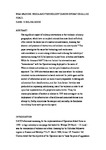War Machine: Media and Technology during Operation Allied Force
| dc.contributor.author | Bobic, Nikolina | |
| dc.date.accessioned | 2015-07-22T12:30:00Z | |
| dc.date.available | 2015-07-22T12:30:00Z | |
| dc.date.issued | 2015-12-17 | |
| dc.identifier.issn | 1033-1867 | |
| dc.identifier.issn | 2164-4756 | |
| dc.identifier.uri | http://hdl.handle.net/10026.1/3452 | |
| dc.description.abstract |
One significant aspect of military interventions is that violence in binary geographies, which have an implied colonial discourse (such as Serbia), often involve the dialectics of construction and erasure, meaning that absence and presence of destruction and violence run side by side. This paper investigates the ways that technology and media were instrumentalised in miniaturising evidence and reducing the visibility of destruction during NATO’s Operation Allied Force in Serbia and Kosovo. While the dominant NATO rhetoric behind the intervention was “humanitarian” with the Operation being deployed in the name of Western values and civilisation, this text puts forward an alternative argument. The 1999 intervention was a war machine where the military-industrial-media-entertainment network restricted the public gaze and the control of information as well as made it nearly impossible to distinguish information from disinformation, and fact from fiction. Its value was predicated on expressing and showing less of the violence in order to set up a clear representation of a perpetrator and a victim. Thus, the reconceptualisation of borders in relation to 1999 was contingent on the deployment of the infrastructure of satellites and unmanned drones in an attempt to, firstly, miniaturise the weapon and, secondly, de-familiarise the military frame with spectacular speed. | |
| dc.format.extent | 398-416 | |
| dc.language | en | |
| dc.language.iso | en | |
| dc.publisher | Taylor and Francis | |
| dc.subject | Violence Research | |
| dc.subject | 16 Peace, Justice and Strong Institutions | |
| dc.title | War Machine: Media and Technology during Operation Allied Force | |
| dc.type | journal-article | |
| dc.type | Article | |
| plymouth.edition | The Architecture of Border Thinking | |
| plymouth.issue | 3 | |
| plymouth.volume | 25 | |
| plymouth.publication-status | Published | |
| plymouth.journal | Fabrications | |
| dc.identifier.doi | 10.1080/10331867.2015.1077549 | |
| plymouth.organisational-group | /Plymouth | |
| plymouth.organisational-group | /Plymouth/Faculty of Arts, Humanities and Business | |
| plymouth.organisational-group | /Plymouth/Faculty of Arts, Humanities and Business/School of Art, Design and Architecture | |
| plymouth.organisational-group | /Plymouth/REF 2021 Researchers by UoA | |
| plymouth.organisational-group | /Plymouth/REF 2021 Researchers by UoA/UoA13 Architecture, Built Environment and Planning | |
| plymouth.organisational-group | /Plymouth/Users by role | |
| plymouth.organisational-group | /Plymouth/Users by role/Academics | |
| dc.identifier.eissn | 2164-4756 | |
| dc.rights.embargoperiod | Not known | |
| rioxxterms.versionofrecord | 10.1080/10331867.2015.1077549 | |
| rioxxterms.licenseref.uri | http://www.rioxx.net/licenses/all-rights-reserved | |
| rioxxterms.type | Journal Article/Review |


